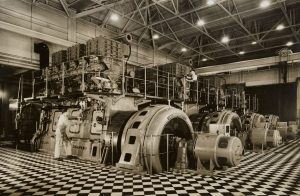2 Chapter 2 – The Contemporary Workplace
The Contemporary Workplace
 Imagine entering the workforce in early to mid-20th century North America (that is just two or three generations ago for most readers…or in other words your grandparents or great grandparents). This era, known as the Second Industrial Revolution, witnessed significant change: the rise of large factories, the implementation of assembly lines, and the beginning of mass production.
Imagine entering the workforce in early to mid-20th century North America (that is just two or three generations ago for most readers…or in other words your grandparents or great grandparents). This era, known as the Second Industrial Revolution, witnessed significant change: the rise of large factories, the implementation of assembly lines, and the beginning of mass production.
During this period, the theories of Frederick Taylor, considered a pioneer of scientific management, held influence. Taylor was convinced that there existed a ‘best method’ for performing every task and that it could be discovered through rigorous scientific analysis. He envisioned the workplace as a system that could be measured, analyzed, and optimized. As a result of his views and others, organizations of that era were built around hierarchical structures, divisions of labor, and top-down communication. In other words, workplaces were designed to be a machine built for maximum efficiency and people were the parts in the machine. We still see the remnants of this today.
Fast forward to today, and the contrast is striking. The late 20th century and early 21st century has seen rapid technological advancement, the rise of the knowledge economy, and the expansion of global trade. And recently the gig economy and remote work have further transformed where and when work is done. Today’s world of work is no longer confined within four walls; it is a network of relationships, it is dynamic, and it is driven by pressure to continually evolve in response to societal shifts. These changes have altered, for many people, organizational goals and the resources and people needed to achieve them.
Today managers and researchers are more interested in what it takes to be adaptable, and to innovate. With this has come an interest in understanding employee engagement and wellbeing, collaboration and self-managed teams, creativity and constant learning. The focus today is not on optimizing the workplace as a machine, rather the interest is in understanding it as networks, the processes of organizing, and the role of communication in shaping team and organizational reality.
The workplace is changing because of things like globalization and technology but it is also changing because of what people want and value in their career. Today younger generations, tend to value experiences and personal growth more than previous generations. This shift in values is driving a demand for careers that offer more than just financial rewards, including opportunities for belonging, learning, fun, travel, and meaningful impact. Many individuals now seek careers that allow them to integrate their work with their values, passions and interests. By taking control of their careers, people are also pushing against the structures that make up organizations. The traditional career path is being altered by an interest in a more personalized and dynamic approach to work.
This historical perspective helps you understand how the structures of the past have evolved to modern workplace structures because of factors in the environment. Interestingly today’s flatter and ever-changing organizations actually want and depend on employees who exhibit agency (more than in the past).
Your “Ethnographic Study”
An ethnographer studying what it means to work would want to start by thinking about how the concept of work is constructed in Western society because work is a cultural concept not just a task.
In Western contexts, “work” is often framed as:
- A source of identity (“What do you do?”),
- A moral obligation (linked to productivity and worth),
- A site of economic exchange (labor for wages),
- A measure of success (career progression, status).
These meanings are not universal, they’re shaped by personal, historical, economic, and ideological forces. Additionally norms such as self-reliance, efficiency, discipline, and achievement influence how people behave at work, how organizations are structured, and how interns or newcomers are socialized. Ethnographers need to recognize these norms to interpret what they observe. Understanding these constructions helps you as the ethnographer to avoid treating work as a neutral or self-evident category. This means you can ultimately better construct your professional identity and your own understanding of work while also recognizing the structures around you.
